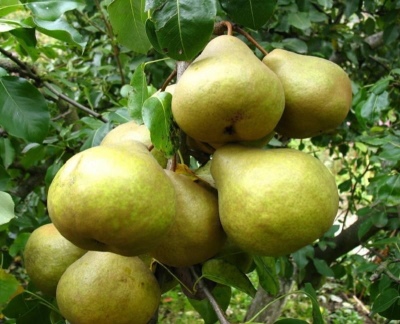
- Fruit weight, g: 190
- Ripening terms: autumn
- Fruit picking time: in the second half of September
- Growth type: medium height
- Yield: high
- Crown: pyramidal
- Fruit shape: broad pear-shaped
- Fruit color: greenish yellow with a blurred blush on the sunny side
- Skin : dry
- Pulp : very juicy, medium density, delicate, buttery
Summer residents with little experience in growing fruit trees try to choose the most unpretentious species for planting, which give abundant fruit yields. One of these is the Platonovskaya pear tree, which grows in different climatic conditions.
Breeding history
Pear Platonovskaya with an autumn ripening period was bred by Ukrainian scientists-breeders of the Institute of Pomology named after L.P. Simirenko. A crop was bred for cultivation in regions with different weather conditions.
Description of the variety
Platonovskaya pear is a medium-sized tree that grows up to 2-2.5 m in height. At a young age, the tree has a pyramidal crown, which changes over the years, acquiring a wide pyramidal contour. The fruit crop is characterized by moderate thickening of the crown with green foliage, drooping and flexible branches during the fruiting period and large fluffy flowers that emit a pleasant aroma during the flowering period.
Fruit characteristics
Pear Platonovskaya represents a class of large-fruited. On a young tree, the fruits reach a weight of 220-240 grams. On an adult tree, the average weight of a pear is 190 grams. The fruit is broad pear-shaped. Ripe fruits have a beautiful color - greenish-yellow with a slight blush that appears from the sunny side. The peel of the fruit is dry and rusty. In the largest fruits, slight ribbing / tuberosity appears.
The advantage of pears is their transportability and long shelf life (fruits can be stored in a cool place for 2-3 months without losing their taste and marketability).
The purpose of fruits is universal, so pears are eaten fresh, used in cooking, canned and processed into marmalade, mashed potatoes, jam.
Taste qualities
The taste and commercial qualities of the fruits of this variety are excellent. The creamy white flesh of the pear is oily, fine-grained, fleshy, tender, of moderate density and very juicy. The taste of the fruit is balanced - bright sweet without sourness. In addition, it is worth noting the incredibly sweet and bright aroma of the fruit, which remains even in processed form. When eating a pear, the skin is not felt at all.
Ripening and fruiting
Pear Platonovskaya belongs to the group of autumn varieties. The tree begins to harvest in the 4th year after planting. Ripening occurs in the first half of September. Mass harvesting begins in the second decade of September and lasts for several weeks.

Yield
This pear species is declared as a high-yielding pear. Subject to the basic rules of agricultural technology and in favorable conditions, about 30-40 kg of fruit can be removed from 1 tree per season.
Self-fertility and the need for pollinators
This species belongs to partially self-pollinated varieties, therefore it is necessary to plant donor trees on the site, the flowering times of which coincide with the Platonovskaya pear.
Landing
You can plant seedlings in spring and autumn. Planting trees in autumn falls on September-October, 3-4 weeks before the first frost. In the spring, it is recommended to plant seedlings during a period when the air and soil are sufficiently warmed up. As a rule, this is the end of March - beginning of April. When planting trees, do not forget about observing the distance between the seedlings so that the trees do not shade each other.


Growing and caring
Pear Platonovskaya is not capricious in care, but prefers fertile, loose, moisture and air-permeable soil with a deep passage of groundwater. The garden area should have abundant sunshine and be protected from drafts and strong winds.
Comprehensive care consists of the following measures: watering, fertilizing, protection from insects and viruses, weeding and mulching of the near-stem zone, as well as sanitary pruning of branches. In addition, do not forget about crown formation and foliage thinning. In regions with cold winters, protection of trees and rhizomes is required. As a rule, this is mulching and winding of the trunk.



Disease and pest resistance
The fruit tree has a high immunity to many pear diseases (scab, powdery mildew, root rot), but preventive measures should be taken. Spraying with special agents containing copper sulfate will help protect the fruit tree from pests.

Like any other fruit trees, the pear needs protection from various diseases and pests. When planting a pear on your site, you need to know in advance what diseases you should beware of. To successfully carry out the struggle, it is necessary first to correctly identify the cause of the problem. It is important to distinguish signs of disease from manifestations of the presence of insects, mites, caterpillars and other types of pests.
Resistance to soil and climatic conditions
Stress resistance of this pear species is good, so the tree grows well and bears fruit in different climatic conditions. The pear is frost-resistant, and also easily tolerates short-term drought and heat.
Review overview
Pear Platonovskaya has long taken its place in the list of fruitful and non-capricious varieties that are grown both in summer cottages and on farm lands. The popularity of the variety is due to the fact that the tree gives abundant and stable yields, and also quickly adapts to soil and climatic conditions. In addition, pears captivate with excellent taste and attractive presentation.





































































